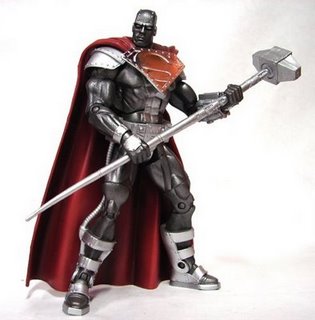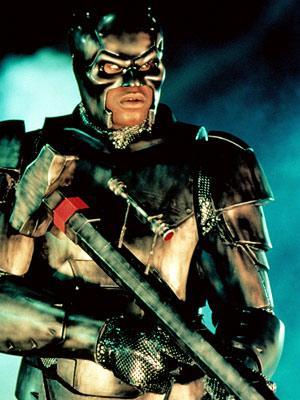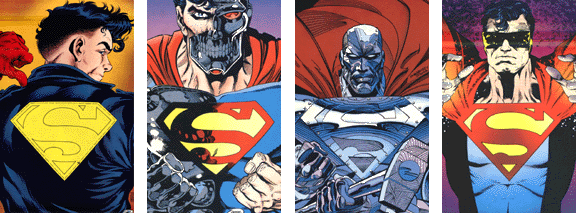John Henry Irons, Superman, Steel (Fenzel)
I’ve known John Henry Irons as long as I can remember. He’s a gentle man, a strong man, and a funny man. He has a finely developed appreciation for 19th century American folklore. He knows the heft and efficacy of the working man’s hammer. He has a thorough grasp of advanced electro-laser particle physics or whatever the Hell kind of science he’s really good at.
He never makes a big deal out of the fact that he got to be in all those comic books, or that he had his very own movie, Steel, where he got to watch master thespian and pretty good basketball player Shaquille O’Neal tell part of the story of his remarkable life.
Of course, the movie left out his inspiring relationship with Superman, and the key role Mr. Irons (I’m sorry, Dr. Irons) played in the death and return of Kal-El, America’s greatest immigrant.
John smiles as he tells the story, “I don’t know what I was thinking, picking up that hammer. Was I going to hit him? Maybe. But with Doomsday fighting Superman – Superman! – I had to do something. You see, Superman saved my life, and he asked me to live a life worth saving. So I decided, in that moment, when Superman was about to die, to make a highly symbolic gesture of defiance, drawn of course from my favorite hobby – the study of 19th century American folklore – and then to get buried under a pile of rubble. Some people call it an early expositional cameo; I call it a subtle narrative commentary on the free black man in industrial America.
The whole ‘design a suit of power armor and become the black Superman’ thing was an afterthought, not to mention fighting that evil arms manufacturing company, or that entropy alien from another dimension, or all those gangs, or running that hospital. Why did they let me do that? I’m not qualified to run a hospital. I don’t know anything about the medical profession, I run a company called ‘Steelworks.’
 Yeah, wow, I’ve done a lot of stuff.”
Yeah, wow, I’ve done a lot of stuff.”
As John so humbly relates (and I’m totally calling him on it this time!), after Superman died, he designed and put on a powerful suit of armor and took his place as the fourth person who tried to step in and fill the big man’s red go-go boots. But whereas the Man of Tomorrow (Cyborg), the Metropolis Kid (Superboy) and the Last Son of Krypton (bullshit energy-based alien) all claimed in one way or another to actually be Superman, John Henry Irons was more humble.
“Well, for one, we’re not the same person – but none of us were. You had to be dense (Like Steel? – Ed.) to think any of us were the real Superman, but for me, it was the most obvious. I’d known him when I was alive. I was there when he died. It was all a matter of public record. I know his secret identity – Clark Kent is a friend of mine.
Also, I don’t know if you noticed this, but I’m black.”
On this day when we obliquely celebrate G.I. Joe, and its stirringly vague suggestion that we ought to love our country by shooting the bejeezus out of something vaguely foreign, alien or evil with laser beams, I can think of no greater example of the virtues of our country – no more Real American Hero – than the man who never claimed to be Superman, except as an over-elaborate metaphor, but who was grouped with all the people who did anyway.
Like all truly Real American Heroes, Steel resides in Jersey City, New Jersey.
![The Best Fake Real American Hero [Think Tank]](https://www.overthinkingit.com/wp-content/uploads/2009/08/gijoethinktank.jpg)


I have to wonder why Snake Plissken was not brought up as one of the greatest real (fake) American heroes. He represents both the patriotic spirit of America as he has saved the president,and served in the military. Though a military man at first, be becomes disillusioned with that aspect, as many Americans have within recent history. He became more of a “lone wolf anti-hero” a common trait within modern American heroes. His personality has been so powerful and memorable, that he was the inspiration for the greatest real (fake) American hero that Japan has ever created, Solid Snake, from the Metal Gear Solid games.